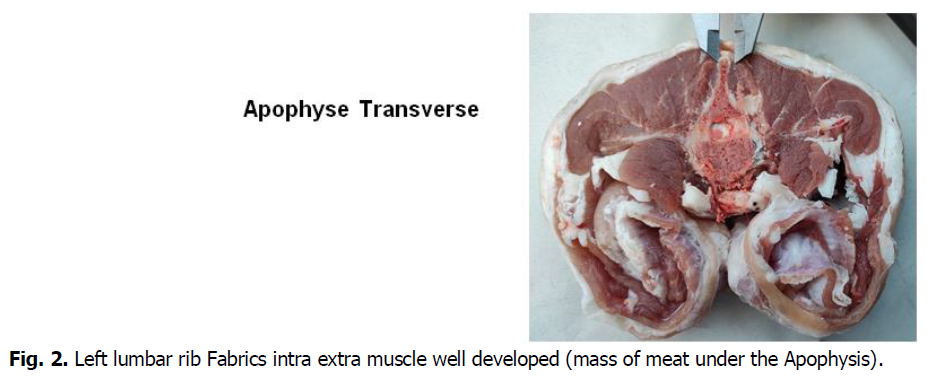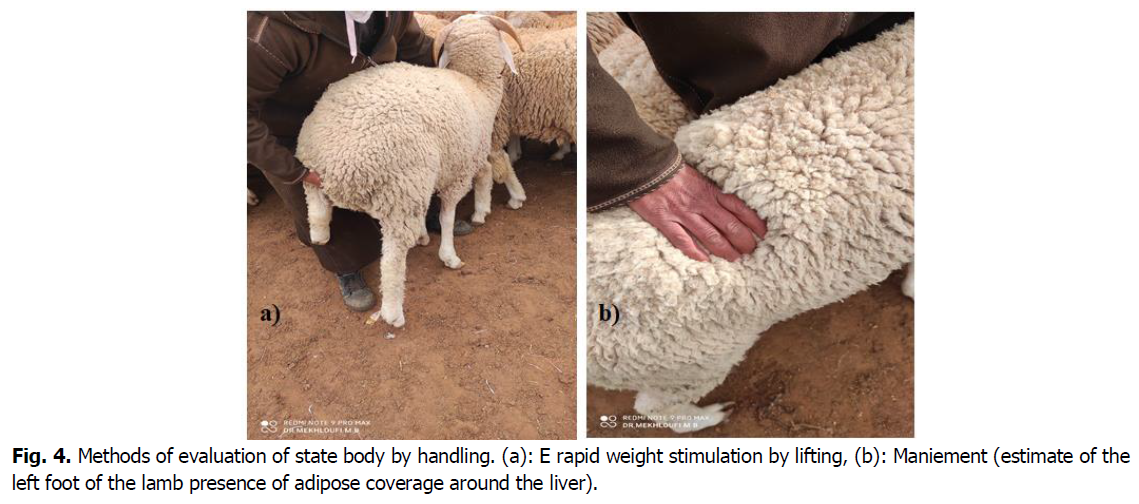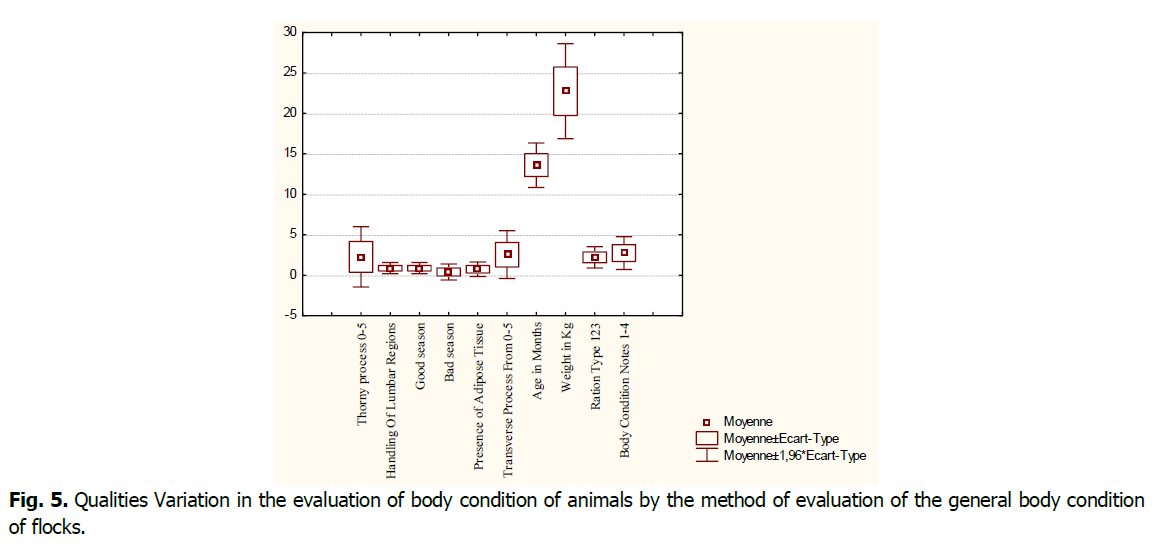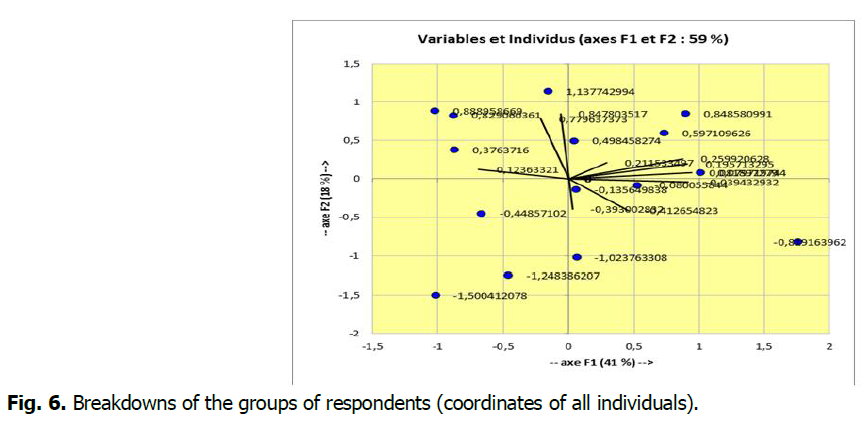Research - (2022) Volume 12, Issue 4
Evaluation method of general body condition of livestock sheep by realignment of lumbar regions in the race Rembi in the El Bayadh region
M.M. Brahim1*, N. Tayeb2, M. Latifa1, B.B. Abderezek1 and M. Khader3Abstract
The production of meat from sheep breeding in the so-called steppe zone is characterized by respectful organoleptic qualities and comes from the diverted rations characteristic of each zone distributed by farmers for their animals. The protein source from the vas deferens of the sheep carcass constitutes an important indicator sought by breeders for years in the area of study to ensure the good quality of meat produced in their farming systems guaranteeing therefore good sales of their livestock based on overall body condition of their animals. One of the most efficient and rapid methods of judging the body condition of the animal is the reshuffle on the lumbar regions. In our research, the main objective was to distinguish the deferent criteria of this quality evaluation in the study area. A total of three samples randomly each containing 45 samples of lumbar regions removed from the carcass showed the most popular place in the market for lamb aged on average 13.6 months, and an average weight of 22.7 gk, good for two years. Our results showed very highly significant values (P˂0.05) related to the importance of weight as a classification criterion for strong type carcasses. The study concludes that the food strategy acts as an excellent resource that acts directly on the quality of the meat and the presence of fair quantity of adipose mass explained this values in the choice of the performing races participates in the evaluation of the quality of the meat.
Keywords
Spinous apophysis, Body condition, Lambs, Adipose tissue, Transverse apophysis.
Introduction
In Algeria, local sheep breeds are exploited according to mixed production systems (meat, wool and milk); meat production is traditionally obtained from adult animals, lambs weaned late after more than three months of suckling are finished in fattening workshops and generally slaughtered between 35-40 kg (Benyoucef andal, 1995).
Evaluating the body composition of ruminants has always been a topical issue. The nature of the estimation of the conformation and the state of fattening has led to further investigation into the development of different techniques which would allow the evaluation and consequently the classification of carcasses (INTERBEV-OFIVAL, 2002).
The study of the composition and the structure of the latter is a very important part because it represents the best tool for the evaluation of the meat value of the animals and thus constitutes the basis of the different classification systems which condition the transaction in this area (Bourfia and Echiguer, 1991, Toussaint, 2001).
The economical production of good quality lambs (i.e., fast growing lambs giving carcasses without excess fat), requires rigor in breeding methods and especially rationing (Boquier, et al., 1988; Dudouet, 1997). This is a very delicate operation since the performance of lambs strongly depends not only on the quantity of grass offered but also on its quality (Dudouet, 1997).
The parameters relating to conformation and fattening state are those chosen for their importance in lambs (Colomer Rocher and Kirton, 1975).
It follows that as soon as the lamb reaches a live weight of 30 to 40 kg, it shows a clear tendency to gain fat. The composition of the kg of live weight gain therefore changes during growth; Fat and energy contents steadily increase to the detriment of water (Paquay and Bister, 1987).
The aim of this study is to distinguish the deferent criteria of morphological quality of the lumbar regions of the Algerian sheep breeds (Rumbi) in order to contribute to a better knowledge of the specific protein resources has socio-economic impacts is on the breeding management strategies in steppic environment which remain until now little known and very little studied.
Materials and Methods
Description of animal material
Our study focused on the lumbar regions belonging to the lambs of (Rumbi) breed slaughtered under normal conditions after fattening in the commercial. The studied sampling is based on 135 carcasses of lambs selected from different sites of the study region.
Description of the breed
All the animals are called Rumbi because it is the dominant breed in terms of the number of people in the region, making more than half of the total labour force nationally (Kerbaa, 1995).
The slaughtered animals are lambs at the average age of 13.6 months. In our study all carcasses belong to whole lambs raised and fattened to be prepared for slaughter; it is this type of lamb that dominates in the sales structure during the year compared to the heavy periods of consumption. Gender also has its influence on the state of fattening since males produce carcasses heavier but less fatty than females (Girard et al, 1985; Dimsoski et al, 1994; Jeremiah, 1998).
Examination of the lumbar regions of animals
By direct measurement: It simply consists of measuring with a caliper the thickness of the covering tissues at determined points:-at the level of the last lumbar vertebra, 4 cm to the right of the spine (El Fadili et al., 1997) at the height of the 13th vertebra, 4 cm from the spine (Diaz et al, 1981). -4 cm behind the last rib at 4 cm from the middle of the carcass (Miguel, 2003), this technique is simple to implement but remains very manual.
Importance of Presences of the adipose mass on the lumbar regions
Depending on the anatomical location, it is customary to distinguish 4 different types of fat: (Girard et al, 1986):
• Internal fat is deposited first in the abdominal cavity and lines the thoracic and abdominal cavities.
• Intermuscular or marbled fat: is deposited between the large bundles of muscles.
• Subcutaneous or covering fat: constitutes the covering deposits.
• Intramuscular or marbling fat: develops in the muscle bundles giving the meat a taste.
These fatty deposits are generally important to consider because of their economic impact on production, inter and intra muscular deposits are also important by their quantity and nature, because they influence the organoleptic and nutritional qualities of the meat.
In the lumbar regions, this mass of meat and fat (marbled and marbled) bears on the bones known as the Spinous Apophysis and Transverse determines in fact their structure (Fig. 1).

Fig 1. Thicknesses of the tissues between the Transverse Apophysis well appears) Transverse and the Apophysis are well rounded.
Several studies have shown in sheep as in cattle 3 periods of relative increase in fat content with a first period of rapid increase followed by a second period of more moderate increase and finally a period of rapid increase (Robelin et al., 1979 cited by Girard et al., 1985).
Direct measurement of the thickness of the meat mass: Animals of the same species do not always have the same development capacity and depending on their genotype, their growth potential and their capacity for fattening are different. Consequently, the great effect on the proportion of muscles and their characteristics of the carcass (Hanrahan, 1999). The Fig. 2 shows the presence of ground meat and branching of fat years the total volume of lumbar.

Fig 2. Left lumbar rib Fabrics intra extra muscle well developed (mass of meat under the Apophysis).
In good breeding conditions, a mass of meat under the Apophysis appears and makes it possible to cover the needs of this region Fig. 3, the handling attains these regions and makes it possible to effectively complete the technique of total evaluation of the individual Fig. 4.

Fig 3. (a) and (b): Coverage measurement (presence of meat mass and branching of the lumbar adipose tissue).

Fig 4. Methods of evaluation of state body by handling. (a): E rapid weight stimulation by lifting, (b): Maniement (estimate of the left foot of the lamb presence of adipose coverage around the liver).
Statistical analyzes
The use of PCA which, generally serves to reduce information through discrimination as well as a graphical representation of correlations, this method allows us to analyze the correlations between the different variables and identify the races that are distinguished from others According to Dagnelie (1970). For a PCA the connection, in the statistical sense, between two variables will be all the stronger the closer their vector directions are, the smaller the angle formed by the two vectors. The results come from ANOVA calculations based on STATISTICA and StatBox software version 6.4.
Data collection and studied factors
Fig. 5 illustrates the variations of the qualities of evaluation of the body condition of the animals according to the different variables. The results are confirmed by the analysis of variance They show that there is a very strongly significant effect (p<0.05) (Table 1) on the rearrangement modes of animals according to age and weight. Both parameters relating ement to Spinous Apophysis from 0-5 and Transverse Apophysis from 0-5 represent and certify the basis of evaluation of general body condition of livestock by farmers.

Fig 5. Qualities Variation in the evaluation of body condition of animals by the method of evaluation of the general body condition of flocks.
| Parameters | Average | Ec-Type | NOT | Error-T | T value | p |
|---|---|---|---|---|---|---|
| Spinous Apophysis 0-5 | 2.26667 | 1,907379 | 15 | 0.492483 | 4.60253 | 0.000410 |
| Handling Of Lumbar Regions | 0.86667 | 0.351866 | 15 | 0.090851 | 9.53939 | 0.000000 |
| Good season | 0.86667 | 0.351866 | 15 | 0.090851 | 9.53939 | 0.000000 |
| Bad season | 0.40000 | 0.507093 | 15 | 0.130931 | 3.05505 | 0.008564 |
| Presence of Adipose Tissue | 0.73333 | 0.457738 | 15 | 0.118187 | 6.20484 | 0.000023 |
| Transverse Apophysis From 0-5 | 2.53333 | 1.505545 | 15 | 0.388730 | 6.51695 | 0.000014 |
| Age in Months | 13.60000 | 1.404076 | 15 | 0.362531 | 37.51406 | 0.000000 |
| Weight in Kg | 22.73333 | 2.987275 | 15 | 0.771311 | 29.47363 | 0.000000 |
| Ration Type 123 | 2,20000 | 0.676123 | 15 | 0.174574 | 12.60208 | 0.000000 |
| Body Condition Notes 1-4 | 2.73333 | 1,032796 | 15 | 0.266667 | 10.25000 | 0.000000 |
Table 1. Comparison of means to a standard (constant).
The correlation circles (Fig. 6) correspond to the projection of the initial variables on a two-dimensional plane made up of the first two factors. The projection of the points on the circle is relatively close to the center of the circle. This shows that the results are in accordance with the qualitative values close to the two axes and with a significant representation of 59% on both dimensions.

Fig 6. Breakdowns of the groups of respondents (coordinates of all individuals).
ANOVA Table 2 clearly explains the homogeneity of the averages obtained for the presence of fat levels as according to the season. If the season and good balanced diet is in the form of fat deposition in the lumbar regions, the results of years that sense this e with average homogeneous between 2.2 and 2.7 in the four qualitative parameter is (Spinous Apophysis 0-5, Transverse Apophysis From 0-5, Ration Type 123 Body Condition Notes 1-4). On the contrary if the season is bad fat are almost missing volume meat narrow, therefore the Spinous Apophysis are sharp and appear and Transversal Apophysis are rounded and uncovered meat, it reflected and deflected the fact of handling the critical state of stocks.
| Parameters | Rank | Sum | Average | Ec-type |
|---|---|---|---|---|
| Spinous Apophysis 0-5 | 5.2 | 78 | 2.26667 | 19,07,379 |
| Handling Of Lumbar Regions | 3.43333 | 51.5 | 0.86667 | 0.351866 |
| Good season | 3.33333 | 50 | 0.86667 | 0.351866 |
| Bad season | 2.23333 | 33.5 | 0.4 | 0.507093 |
| Presence of Adipose Tissue | 2.96667 | 44.5 | 0.73333 | 0.457738 |
| Transverse Apophysis From 0-5 | 6 | 90 | 2.53333 | 1.505545 |
| Age in Months | 9 | 135 | 13.6 | 1.404076 |
| Weight in Kg | 10 | 150 | 22.73333 | 2.987275 |
| Ration Type 123* | 6.23333 | 93.5 | 2,20,000 | 0.676123 |
| Body Condition Notes 1-4 | 6.6 | 99 | 2.73333 | 10,32,796 |
Table 2. ANOVA by Friedman & Coef. from Concord. of Kendall (Sheet.sta) ANOVA of Chi2 (N = 15, dl = 9) = 106.5052 p <.00000 Coeff. of Concordance =, 78893 Avg. r =, 77385.
Discussion
These lumbar regions present morphology and vas type measuring a very large sample, they were characterized according to the diet of animals and the duration grazing in the steppe areas in a definite time.
The quantity and nature of the cattle feed distributed to the animals is liable to vary to a large extent. The quantitative and qualitative aspects of fat synthesis; indeed, even short-term changes strongly modulate the metabolic activity (lipogenesis) of adipose tissue in ruminants (Faulconnier et al., 1999).
Our breeders say the food ration composed of barley; sound (Commonly known as Daka), maize and flour, adding the taste by complementary aromatic plants in pasture such as Artemisia herba-alba (chih), and Hammada scoparia (Remth..) are more favored. These plants give their secret flavors to the quality of meat in this region. The lambs graze without restrictions in the first 6 months of their age before weaning, i.e., 0.5 kg of the daily ration and reaching 0.2 kg at the age of 14 months.
Our results demonstrated the importance of weight as a classification criterion for heavy type carcasses averaging 22.7 Kg Table 1 related to back fat thickness and carcass length and thorax and pelvic widths, justifying the good conformation of the individual.
Conformation is the quality and distribution of muscles in the carcass, describes the carcass in terms of shape and profile, and indicates the distribution of all muscle and fat according to the skeleton (West, 1995; Fisher and Heal, 2001).
A good conformation has some interesting technological consequences in terms of the thickness of the muscular planes; well-shaped lambs have a thick chop head and a more advantageous muscle-to-bone ratio than elongated animals with flattened shapes (Boccard, 1979).
Of all these factors, slaughter weight is the one that has been discussed the most in the literature; a good number of authors assert that the proportion of fat in the carcass is related to growth and increase in weight (Chestnutt, 1994; Pollot, 1994; Levalley, 1995) and that the thickness of the fat covering increases proportionally with the size and weight of the carcass (Sanz et al, 1995; Bayandir, 1980 cited by Macit, 2001; Goulet, 2002).
Season effect
The herds of steppe areas are fed according to the season:-from February to March: the animals are put on rented land to graze the young shoots of barley or oats in addition to the shrubs-from April to June and on stubble on autumn grass regrowth.
During the cold period, when the development of the vegetation is very limited, the animals receive supplements of barley and bran and corn.
Weak animals, rams as well as newly-lambed ewes and weaned lambs are kept in the sheepfold and fed with fodder supplemented with barley (Ghimouz, 1978).
The seasonal effect is very dreadful during the winter while recording a significant increase in the prices of agricultural by-products.
Conclusion
A well balanced diet plays an important role in the distribution of the fatty filaments intra and extra muscular in the pieces indicating the state of body of the whole of the animals.
Breeders say that the grazing of aromatic plants in the steppe region example the Artemisia herba-alba (C HIH) give the organoleptic characteristics. The greasy filaments give the taste to the meat of the regions very significant lower back. In parallel the effect of the intensity loam stored all throughout the day are accumulated in those governed lambaires. This is why these regions are economically important, also as a crucial indicator, the assessment of the overall body state of the herd.
At the end of this study, the lumbar regions studied in the Rumbi breed show very specific morphological aspects and an aptitude to accumulate more fat with age. So, the evaluation of the animal product involving the choice of the breed, age and food ration.
Slaughter weight and type of supply response to particular market The marketing of quality carcasses requires a better extension of you chnical less expensive and disseminated pre breeders and traders in order to help develop the sheep breeding sector this region and in the territory of Algeria.
Authors Contribution
All my sincere thanks to the breeders of the region of El-Bayadh in particular the breeders of the municipality of EL-Ghassoul for their massive contribution to the realization of this work.
Conflict of Interest
The authors declare no conflict of interest.
References
Benyoucef, M.T., Zahaf, A., Boutebila, S., Benaissa, T., Kaidi, R., Khellaf, D., Benzidour, A. (1995). Organizational and technical aspects of a genetic study program for the Hamra sheep breed in the Western region (Algeria). In: Gabiña D. (ed.). Strategies for sheep and goat breeding. Zaragoza: CIHEAM, pp:215-224.
Bourfia, M., Et-Echiguer, M. (1991). Prediction of carcass composition of D'Man lambs. CIHEAM, Mediterranean Options, 13:129-132.
Bocqier, F., Theriez, M., Prache, S., Brelurut, A. (1988). Feeding of sheep. Feeding of cattle, sheep and goats. INRA. Paris, pp:249-271.
Boccard, R. (1979). The quality of carcasses and meat. PATRE, 267:9-12.
Chestnutt, D.M.B. (1994). Effect of lamb growth rate and d growth pattern on carcass fat levels. British Society of Animal production. Animal Production, 58:77-85.
Colomer, R.F., Kirton, A.H. (1975). The bases of classification of sheep carcasses, analysis of the new classification of sheep carcasses. ITEA, 21:26-57.
Dagnelie, D. (1970). Statistical theories and methods: agronomic applications. Gembloux Agronomic Presses. Ed Duculot, p:451.
Dudouet, C. (1997). The production of sheep. Edition France Agricole, p:357.
Dimsoski, P., Clay, J., Irvin, K.M. (1995). Influence of management system on litter size, lamb growth, and carcass characteristics in sheep. Animal Sciences Research and Reviews. Special Circular, p:156.
Faulconnier, Y., Bonnet, M., Bocquier, E., Leroux, C., Hocquette, J.F., Martin, P., Chilliard, Y. (1999). Regulation of lipid metabolism in adipose and muscle tissue in ruminants. Food level and photoperiod effects. INRA. Production Animal, 12:287-300.
Fisher, A., Heal, J. (2001). Carcass classification, beef and sheep. Livestock Knowledge Transfer course, University of Bristol, p:314.
Jeremiah, L.E., Tong, A.K.W., Gibson, L. (1998). The influence of lamb chorological age, slaughter weight and gender on consumer acceptance. Sheep Goat Research Journal, 14:206-213.
Hanrahan, J.P. (1999). Genetic and non-genetic factors affecting lamb growth and carcass quality. Teagasc. The irish agriculture and food development authority. Project Report, p:2551.
Interbev, O. (2002). Methods of Measuring Fatigue and Body Composition.
Ghimouz, T. (1978). Analysis of some aspects of sheep farming in Algeria. Doctoral thesis ISV Constantine, p:34.
Girard, J.P., Randriamanarivo, M., Et Denoyer, C. (1986). Animal lipids in the meat sector. INRA Meat Research Station, 2:158.
Girard, J.P., Bucharles, C., Gerardot, L., Et Denoyer, C. (1985). Animal lipids in the meat industry. INRA Meat Research Station, 1:112.
Goulet, F. (2002). Choosing quality to stand out: portrait of the Quebec classification system for heavy lambs. Sheep Symposium, CRAAQ, pp:44-57.
Levalley, B., Smith, G.C., Wise, J.W. (1995). Comparison of methods for evaluating external fat thickness and body wall thickness. Sheep research highlights, Department of Animal Sciences, Colorado University, pp:15-19.
Macit, M. 2001. Growth and carcass characteristics of three fat tailed pure breeds under grazing with concentrate supplementation. Ataturk University.
Paquay, R., Bister, J.L. (1987). Breeding, introduction and factors of productivity. Agriculture Review, 3:573-585.
Pollot, G.E., Guy, D.R., Croston, D. (1994). Genetic parameters of lamb carcass characteristics at three end-points: fat level, age and weight. Animal Production, 58:65-75.
Sanz, M.R., Ruiz, I., Gil, F., Boza, J. (1995). Classification and composition of pre-ruminant kid goats of the Granadina breed, CIHEAM-IAMZ, pp:197-202.
West, G.P. (1995). A glossary of livestock and equine terms. Black's Veterinary Dictionary.
Author Info
M.M. Brahim1*, N. Tayeb2, M. Latifa1, B.B. Abderezek1 and M. Khader32Laboratory of Biodiversity and Conservation of Waters and Soils, Abedhamid Ibn Badis Mostaganem University 27000, Algeria
3Faculty of Sciences of Nature and Life, Ziane Achour University of Djelfa, Algeria
Citation: Brahim, M.M., Tayeb, N., Latifa, M., Abderezek, B.B., Khader, M. (2022). Evaluation method of general body condition of livestock sheep by realignment of lumbar regions in the race Rembi in the El Bayadh region. Ukrainian Journal of Ecology. 12:61-67.
Received: 28-Mar-2022, Manuscript No. UJE-22-58784; , Pre QC No. P-58784; Editor assigned: 30-Mar-2022, Pre QC No. P-58784; Reviewed: 12-Apr-2022, QC No. Q-58784; Revised: 16-Apr-2022, Manuscript No. R-58784; Published: 23-Apr-2022, DOI: 10.15421/2022_365
Copyright: This is an open access article distributed under the terms of the Creative Commons Attribution License, which permits unrestricted use, distribution, and reproduction in any medium, provided the original work is properly cited.
